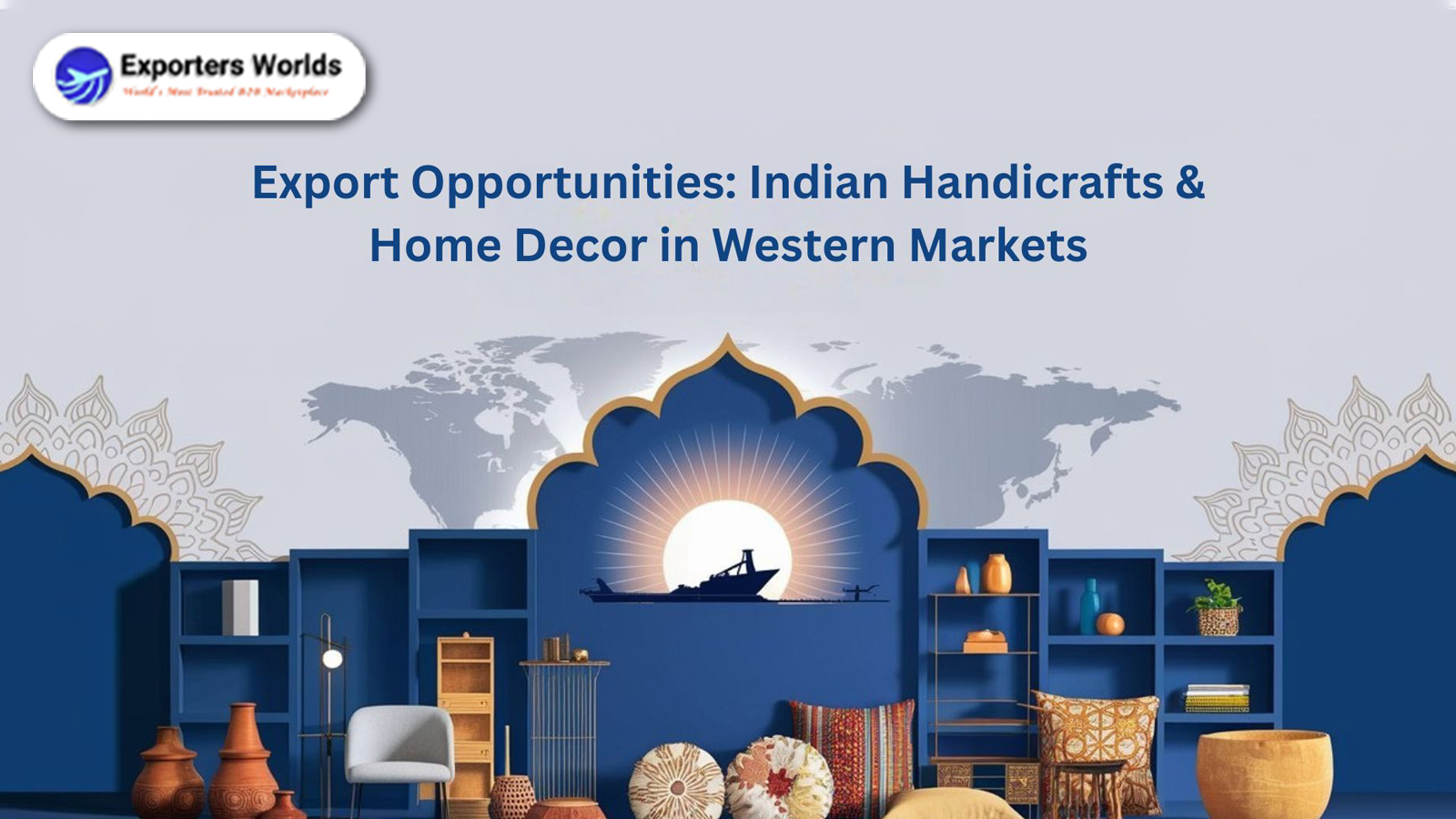Export Opportunities: Indian Handicrafts & Home Decor in Western Markets

Walk into a home in London, Paris, or Los Angeles and you’ll almost always spot a touch of India somewhere. Maybe it’s a block-printed quilt draped across a sofa, a brass lamp glowing in the corner, or a handmade terracotta vase on the dining table. These aren’t just “things” — they’re fragments of culture, stitched and carved into people’s everyday lives.
And here’s the interesting part: this growing obsession has put Indian handicrafts export right in the spotlight. Western markets are actively searching for authenticity, for décor that tells a story, for sustainable pieces that don’t look like they rolled out of a giant factory. Exactly what Indian artisans have been creating for centuries.
So the big question is: how do Indian suppliers tap into these export opportunities for Indian handicrafts in Western countries without losing the soul of what makes them unique?
Why Western Markets Can’t Get Enough of Indian Handicrafts
Here’s what’s happening in the West right now:
-
Personal stories sell: A Kashmiri papier-mâché box isn’t just storage — it carries folklore. A Rajasthani mirror isn’t just décor — it’s heritage on a wall.
-
Eco is not a trend, it’s a demand: 3 out of 4 Western buyers (77% according to Deloitte) say they prefer natural, recycled, or eco-friendly materials. That’s a space where home décor export India naturally thrives.
-
Design trends align: Boho-chic interiors in California, Scandi-rustic homes in Berlin, slow-living corners in Copenhagen — all of them welcome Indian textiles, ceramics, and woodwork without hesitation.
So when people ask about Indian home décor and handicrafts export market trends, the answer is simple: they fit perfectly into Western tastes right now.
The 5 Big Movers in Handicrafts & Home Décor Export
1. Wooden & Metal Handicrafts
-
What sells: carved tables, brass trays, candle holders, lanterns.
-
Why they love it: farmhouse, industrial, rustic — Indian craft slips into all these interior styles.
-
Proof: India shipped out nearly $978 million worth of wooden handicrafts in 2022–23, with the U.S. and Germany leading the demand.
2. Textiles & Furnishings
-
What sells: block-printed bedcovers, handwoven rugs, embroidered cushions.
-
Why they love it: Western homes are often minimalist — these textiles add warmth, a layer of individuality.
-
Proof: Furnishing textile exports stood at $2.2 billion in 2023. That’s not small change — that’s dominance in home décor export India.
3. Pottery & Ceramics
-
What sells: Jaipur blue pottery, terracotta tableware, artisan mugs.
-
Why they love it: handmade ceramics aren’t “flawed,” they’re authentic. That vibe fits right into slow-living lifestyles abroad.
-
Proof: Indian ceramic exports touched $1.6 billion in 2023, a big slice of it heading straight to U.S. and European homes.
4. Jewelry & Decorative Accessories
-
What sells: tribal jewelry, miniature wall art, decorative mirrors.
-
Why they love it: Jewelry doubles as storytelling. Mirrors and wall hangings let buyers “own” a cultural story.
-
Proof: Moradabad’s brassware alone touches $1 billion annually, cementing handicraft suppliers India as serious players here.
5. Eco-Friendly & Sustainable Crafts
-
What sells: bamboo baskets, jute wall décor, recycled home accents.
-
Why they love it: Gen Z and millennials aren’t buying unless it’s sustainable.
-
Proof: The eco-friendly décor segment globally is on track to grow 8.5% CAGR till 2030. For anyone planning to export handicrafts online, this is the jackpot.
Together, these five aren’t just product categories. They’re the roadmap for how to export Indian handicrafts & home décor worldwide.
What’s In It for Indian Suppliers?
Let’s be blunt — this isn’t just about culture, it’s about business.
-
Better margins: That ₹4,000 rug in Jaipur? In New York, it sells at $150.
-
Global demand is niche, not mass: Western buyers actually prefer unique, small-batch runs. Less competition, more exclusivity.
-
Empowering artisans: When exporters crack these markets, even small village workshops get pulled into global trade.
That’s why early movers often become the best Indian handicraft suppliers for global buyers.
Where the Market Is Headed
-
The U.S. imported $2.6 billion worth of Indian handicrafts in 2022 — the single largest buyer.
-
Europe is leaning heavily into ethical sourcing, rewarding certified and fair-trade exporters.
-
Almost 40% of handicraft exports now happen online, through B2B platforms and e-commerce.
If you still think handicraft trade is all about exhibitions and trade fairs, think again. Today, it’s about learning to export handicrafts online and meeting buyers where they already shop.
Quick Facts That Hit Hard
-
India makes up almost 20% of global handicraft exports.
-
Moradabad brassware alone brings in $1 billion annually.
-
Western buyers willingly pay 20–30% more for eco-friendly décor.
-
The global handicraft market is projected to hit $1.3 trillion by 2030.
-
Verified Western buyers actively search for the best Indian handicraft suppliers for global buyers every month.
A Case Study
Take a family-run brass workshop in Moradabad. For years, they sold to wholesalers in Delhi. In 2019, they made the jump to export handicrafts online through a B2B portal.
Fast forward four years:
-
They’re shipping to six countries.
-
Sales went up 4x.
-
40 additional artisans found steady work.
The moral? Global trade isn’t just for giant exporters anymore. Even a small workshop can build a footprint with the right platform.
The Challenges Nobody Talks About
Of course, it’s not all smooth sailing:
-
Fragile items mean higher shipping risks.
-
Western buyers demand consistency and certifications.
-
Paperwork (customs, compliance) can overwhelm first-timers.
But these hurdles aren’t roadblocks. They’re just filters. The exporters who adapt — who use verified networks, branding, and digital catalogs — are the ones who make it. That’s the real playbook for how to export Indian handicrafts & home decor worldwide.
Closing Thoughts: India’s Story, The World’s Home
At the end of the day, this is bigger than just trade. When Indian artisans reach Western homes, they carry with them centuries of craft, heritage, and pride. And the demand is not slowing down — in fact, it’s rising every year.
If you’re a supplier thinking about this journey, here’s the truth: the market is open, buyers are searching, and the time to step in is now. Indian handicrafts export is no longer just an option — it’s one of the fastest-growing ways to connect India’s culture with global living spaces.
That’s where Exporters Worlds comes in. Since 2015, it’s been more than a B2B portal — it’s a bridge. A place where exporters meet verified buyers, get help with trade documentation, even digital marketing and website development. Basically, it’s the partner you want if you’re serious about turning opportunity into results.
So the real question is — will your handicrafts be the next success story in Western markets? If you’ve been wondering how to export Indian handicrafts & home decor worldwide, the answer is right in front of you.




